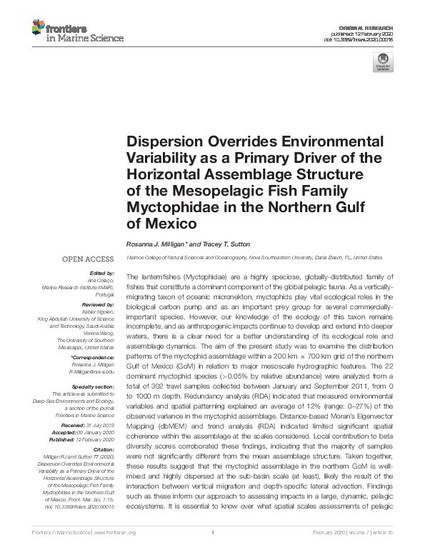
- Beta diversity,
- Deep sea,
- Microneckton,
- Myctophidae,
- Spatial analysis
The lanternfishes (Myctophidae) are a highly speciose, globally-distributed family of fishes that constitute a dominant component of the global pelagic fauna. As a vertically-migrating taxon of oceanic micronekton, myctophids play vital ecological roles in the biological carbon pump and as an important prey group for several commercially-important species. However, our knowledge of the ecology of this taxon remains incomplete, and as anthropogenic impacts continue to develop and extend into deeper waters, there is a clear need for a better understanding of its ecological role and assemblage dynamics. The aim of the present study was to examine the distribution patterns of the myctophid assemblage within a 200 km × 700 km grid of the northern Gulf of Mexico (GoM) in relation to major mesoscale hydrographic features. The 22 dominant myctophid species (>0.05% by relative abundance) were analyzed from a total of 302 trawl samples collected between January and September 2011, from 0 to 1000 m depth. Redundancy analysis (RDA) indicated that measured environmental variables and spatial patterning explained an average of 12% (range: 0–27%) of the observed variance in the myctophid assemblage. Distance-based Moran’s Eigenvector Mapping (dbMEM) and trend analysis (RDA) indicated limited significant spatial coherence within the assemblage at the scales considered. Local contribution to beta diversity scores corroborated these findings, indicating that the majority of samples were not significantly different from the mean assemblage structure. Taken together, these results suggest that the myctophid assemblage in the northern GoM is well-mixed and highly dispersed at the sub-basin scale (at least), likely the result of the interaction between vertical migration and depth-specific lateral advection. Findings such as these inform our approach to assessing impacts in a large, dynamic, pelagic ecosystems. It is essential to know over what spatial scales assessments of pelagic faunal impacts, and potential recoveries, must be based. In cases of large, spatially integrated pelagic assemblages, high dispersal rates may serve to either ameliorate the effects of a disturbance through immigration or spread the effects across a wider spatial area than the disturbance phenomenon footprint itself.
Available at: http://works.bepress.com/tracey-sutton/249/

©2020 Milligan and Sutton. This is an open-access article distributed under the terms of the Creative Commons Attribution License (CC BY). The use, distribution or reproduction in other forums is permitted, provided the original author(s) and the copyright owner(s) are credited and that the original publication in this journal is cited, in accordance with accepted academic practice. No use, distribution or reproduction is permitted which does not comply with these terms.